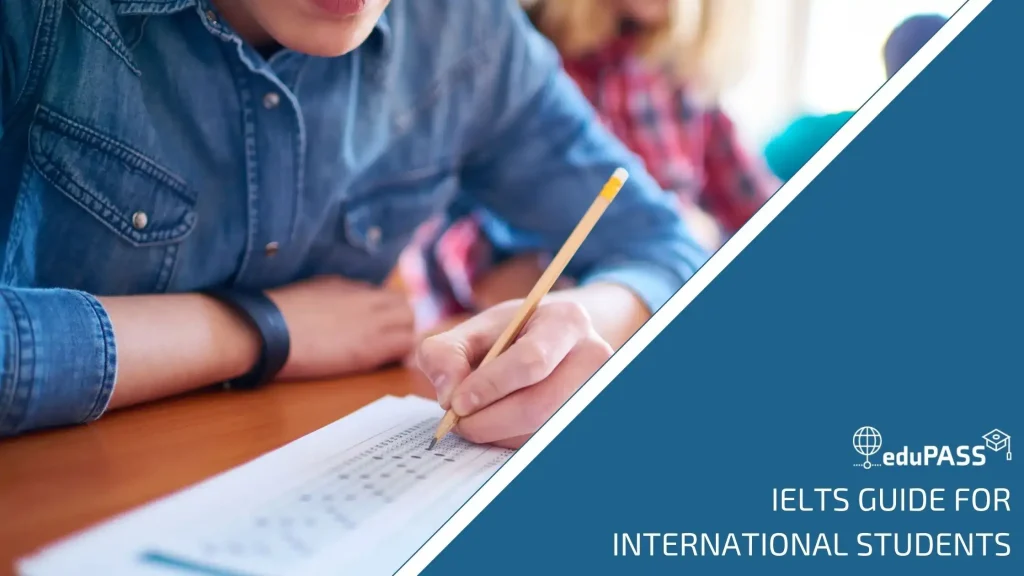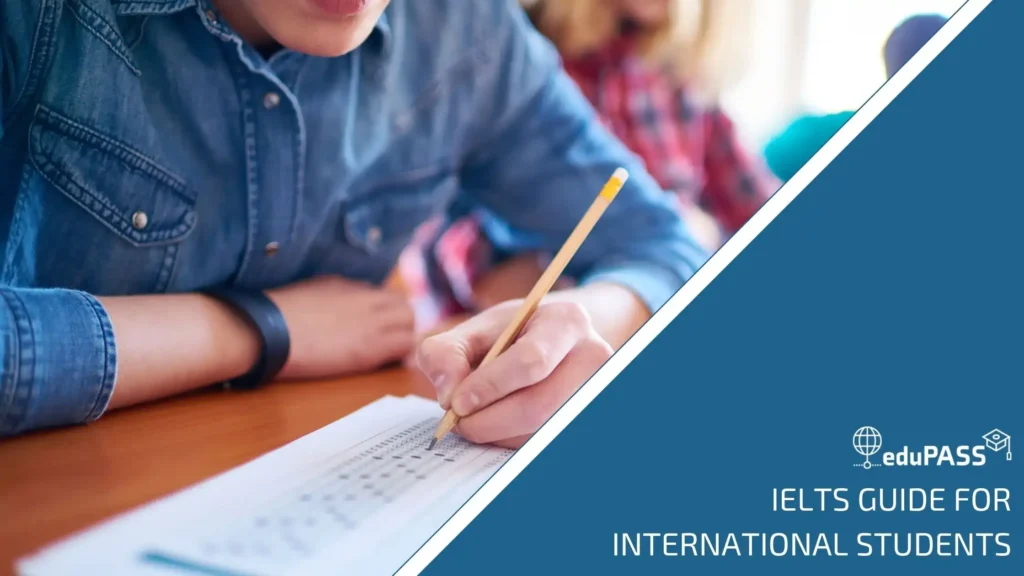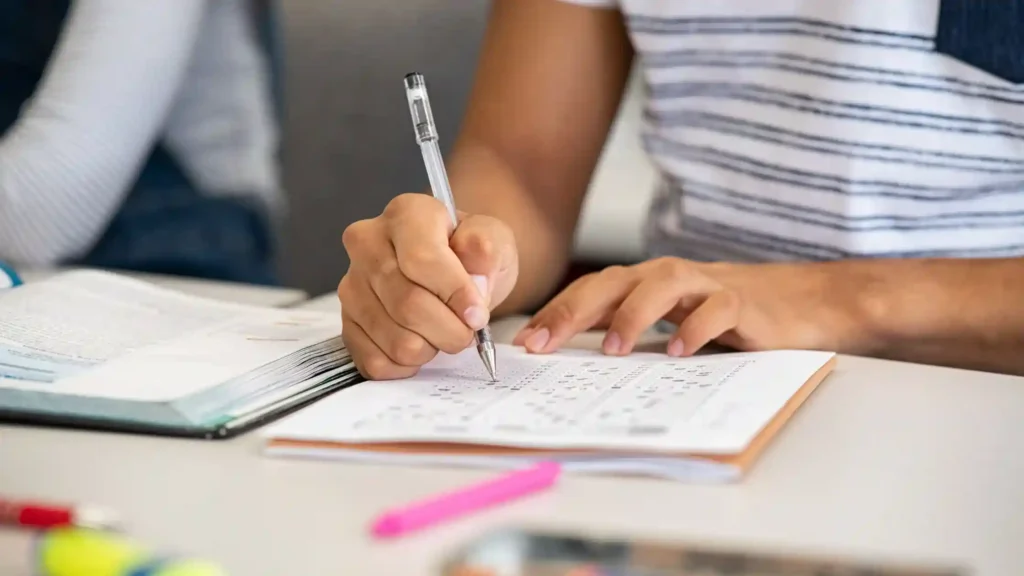

IELTS stands for International English Language Testing System. It’s one of the top tests in the world for proving English language proficiency. Many non-native English speakers need to take the IELTS exam when going to an English-speaking country to live, work or go to school. If you are an international student wishing to study at a university or college in the U.S., you will take the IELTS Academic. You can use your results to prove your English proficiency at an academic level.
What is the IELTS?

The IELTS is an exam testing English proficiency that is jointly owned and offered by the British Council, IDP IELTS and Cambridge University Press & Assessment. The IELTS Academic test is designed to assess your ability to use the English language in an academic setting and to study at the degree level you’ve applied for in countries such as the U.S., the U.K., Canada, New Zealand and Australia. More than 11,000 organizations around the world recognize the IELTS.
IELTS Exam Structure
The IELTS consists of four sections: listening, reading, writing and speaking.
The listening, reading and writing sections are taken together on the same day. However, the speaking part of the test is typically taken a week before or after the other sections. The total time for the listening, reading and writing portions of the test is two hours and 45 minutes. The overall test is broken down as follows:
Listening
This part of the test takes 30 minutes. You will listen to four recordings, including:
- Recording 1 – A casual conversation between two people.
- Recording 2 – A monologue, such as a speech.
- Recording 3 – A conversation between two to four people in an educational setting.
- Recording 4 – A monologue on an academic subject.
This part of the test evaluates your ability to understand what you hear, including the main ideas, facts, attitudes and opinions, and to follow how ideas are developed through speech.
Reading
This part of the test takes 60 minutes. It is made up of 40 questions designed to test your reading skills, including your understanding of the main ideas of the material. You must know how to skim and read in detail to understand any logical arguments and the writer’s attitudes and opinions.
Writing
This part of the test takes 60 minutes. It is made up of two formal writing tasks, as follows:
- Task 1 – In your own words, explain, describe or summarize the information on a graph, chart, diagram or table.
- Task 2 – Write an essay based on a specific problem, argument or point of view.
Speaking
This part of the test takes 11 to 14 minutes. There are three parts as follows:
- Part 1 – Answer questions about yourself and topics familiar to you.
- Part 2 – Discuss a specific topic, with one minute to prepare and two minutes of speaking time.
- Part 3 – Answer questions about the topic you spoke about in Part 2.
IELTS Scoring
The IELTS uses a band score system. Each test section is scored separately on a scale of one to nine in increments of 0.5. Here is a breakdown of what each point on the scoring scale means:
- 1 – Non-user
- 2 – Intermittent user
- 3 – Extremely limited user
- 4 – Limited user
- 5 – Moderate user
- 6 – Competent user
- 7 – Good user
- 8 – Very good user
- 9 – Expert user
You will end up with four scores at the end of your test. These four scores will also be averaged to give you an overall band score. If the average of your four scores ends in .25, your band score will be rounded up to the nearest half point. If the average of your four scores ends in .5, your band score will be rounded up to the nearest whole point.
When qualifying for university, most schools require a minimum overall band score of 6.5 and all individual sections no lower than 5.5. If you don’t score high enough to qualify for acceptance the first time, you will know what areas of English language communications you need to focus on to raise your score. For example, you may have scored well in the listening and reading parts of the test, but not as well on the writing and speaking parts. If you disagree with your scores, you may apply to have your test remarked by a senior examiner.
IELTS Cost
The cost of the IELTS varies by country. Examples of the cost as of 2023 in certain countries are:
- Brazil – 840 BRL
- Canada – CA $319
- China – NTD 7,000
- Denmark – DKK 1,895
- Finland – EUR 250
- France – EUR 235
- Germany – EUR 229
- India – 13250 INR
- Iran – IRR 30,500,000
- Italy – EUR 238
- Japan – 25,380 JPY
- Mexico – MXN 3.600
- Netherlands – EUR 225
- Norway – NOK 2,950/3,000
- Spain – EUR 220
- Sweden – SEK 2,500
- Switzerland – CHF 369
How to Take the IELTS


The IELTS can be taken in a test center on paper or on a computer or remotely online. Online tests are the preferred option and are offered in most countries around the world. Even if the test is taken remotely online, human examiners will monitor the listening, reading and writing parts of the test in real time and grade the test. The speaking test will be done via video conference with a live IELTS examiner.
If you take the IELTS at a test center, you will be supplied with everything you need to take the test. If you are taking the test at home, you will need to have the following:
- A laptop or desktop computer (no Chromebooks, phones or tablets).
- An up-to-date operating system.
- A reliable and fast internet connection.
- The Safe Exam Browser (SEB) downloaded from the IELTS website.
- The Zoom app.
- A web camera, providing a 360-degree view of the room where you are taking the test.
- Internal or external speakers or headphones.
- A microphone.
- A photo of yourself to be checked against a picture of your ID before beginning the test.
You must also ensure that the environment where you are taking the exam is private and quiet. You are not permitted to have phones, smart watches, books or notes nearby or on your person. Once you start the test, your browser will be locked, and you won’t be able to access anything else on your computer.
Once you finish the test, you will receive your results in 13 calendar days for the paper-based test and three to five days after the online test. You can check these results on the Test Taker Portal. Online test results will be mailed to you 13 days after your test date, and results will be sent to institutions requiring an original copy. Test results will not be emailed to you or disclosed over the phone.
If you do not do well enough on the IELTS test, you can retake it as soon as you feel ready. However, to get a better score, you will need to put in the work to improve your English proficiency.
Canceling or rescheduling the IELTS
You can cancel your scheduled test before the test date as follows:
- More than 14 days before – You will get a refund of 75% of your test fee.
- Six to 14 days before – You will get a refund of 50% of your test fee.
- Five days or less – You will not receive a refund.
You can reschedule your test more than 14 days before the scheduled date, typically for 25% of the original test fee.
The new date for your test must be within three months from your original test date. Anything beyond three months will be considered a cancellation. You cannot reschedule your test within 14 days of your test date. This will also be considered a cancellation.
IELTS Preparation


Ultimately, you need to spend significant time preparing for the IELTS test. How much will depend on your current level of proficiency in English. You should begin preparing at least two to four weeks before your test date and use the preparation materials supplied on ielts.org. These include practice tests and other materials. You should also create a study plan and stick with it.
Study tips weeks before the IELTS
Your IELTS study plan should include the following:
- Practice writing English within a strict time frame.
- Practice taking notes in English.
- Practice speaking to yourself in English and practice speaking English with anyone you know who speaks the language.
- Read English writing through news articles, blogs and books.
- Watch and listen to English media, including television shows, movies, radio, videos and podcasts.
- Commit to learning a new word every day.
- Take practice tests before you take the real one to become familiar with the test format and the types of questions.
- Approach practice tests as if they were the real test by checking the answers in each section and timing yourself.
Study tips for the day of the IELTS
Use the English language in every way possible before your test. When your test day arrives, the following tips will help you:
- If you are taking the test in a test center, arrive early enough to register and get settled. If you are taking the test at home, give yourself time to set up your space so you are ready on time.
- Read all the test instructions carefully before you begin the exam.
- Develop a study routine to make the most of your study time. This means setting up a study schedule and sticking with it, ensuring you take breaks and don’t overwhelm yourself.
- Pay attention to the time when taking the test. A clock will be on the wall if you are in a test center. If you take the online test from home, a clock will be on the screen.
- Review your answers for each section after you are finished. You will be given time at the end of each section to go through and check your answers, but once you move on to the next section, you will not be able to go back.
The IELTS Is Important


When it comes to studying in the U.S., being able to communicate in all forms in English is essential, not only for being accepted into your school of choice but also to get the most out of your time in the U.S. The IELTS is one of the best tests to help you assess your English proficiency and see where you need to improve if you aren’t at the level you need to be.
To explore further details about the IELTS exam, browse through eduPASS today for comprehensive information.








